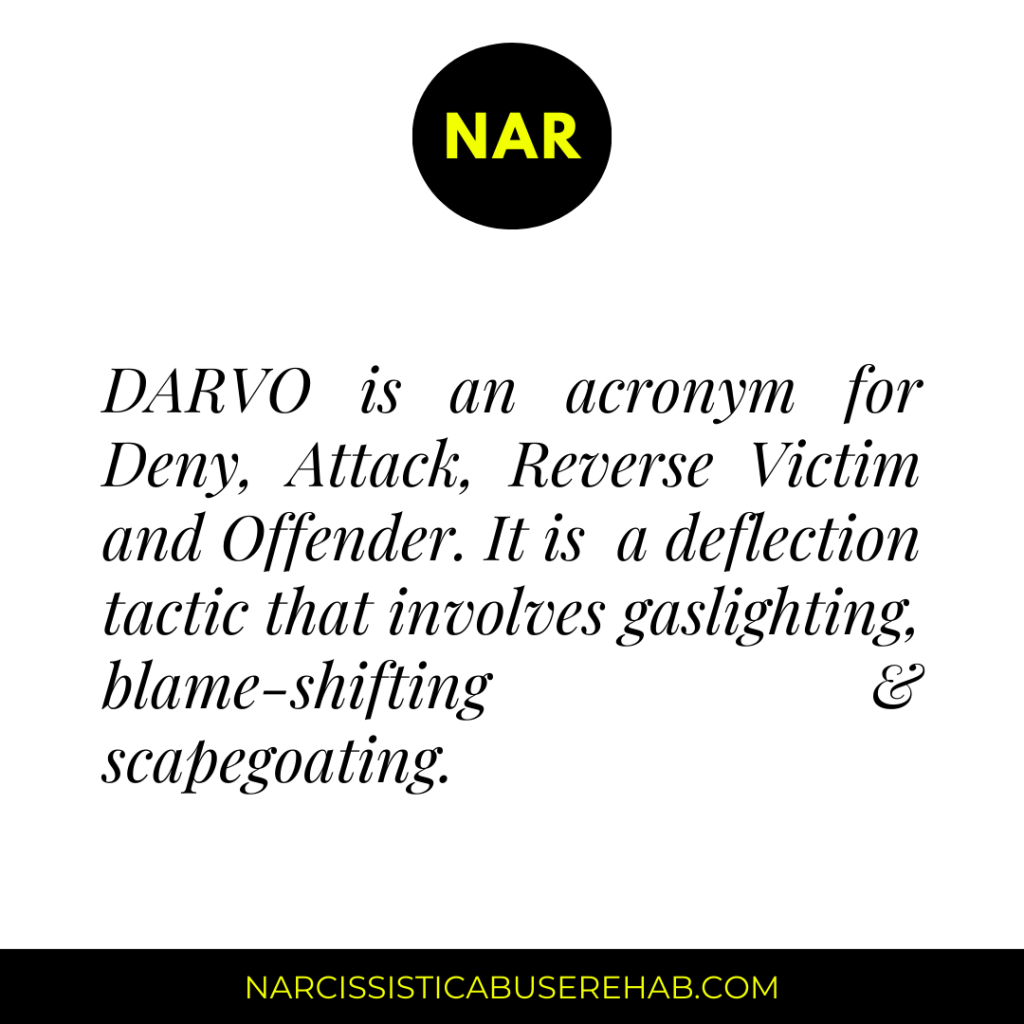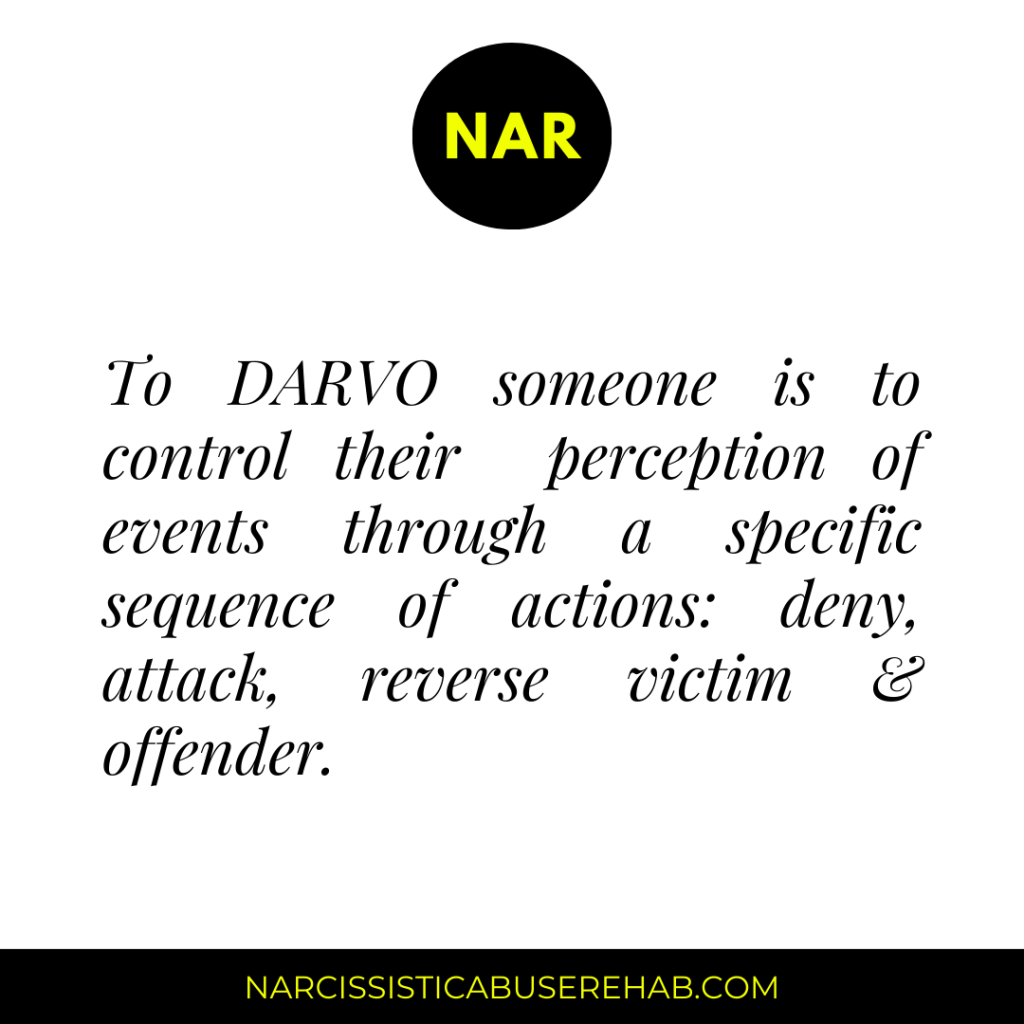DARVO (Deny, Attack, Reverse, Victim, and Offender) is a tactical maneuver manipulators use to groom individuals, and, indeed, entire social groups. It involves controlling people’s perception of events through a specific sequence of actions. Those who experience the DARVO process often feel disoriented as the perpetrator of abuse actively revises the facts and distorts the truth. By crafting a fictional narrative that bears no resemblance to reality, they sow seeds of doubt. Bystanders, regrettably, accept the manipulator’s lies as truth. Meanwhile, the recipient of the abuse becomes a scapegoat and a target of vilification.
In this article you will learn:
- What is DARVO?
- What does DARVO look like?
- Examples of DARVO
- Who gets targeted for DARVO?
- What is the purpose of DARVO?
- DARVO as a collective grooming tactic
- Why bystanders participate in DARVO
- The longterm effects of DARVO on victim-survivors
What is DARVO?
DARVO is an acronym for Deny, Attack, Reverse, Victim and Offender. It is a defense mechanism used by manipulators when they are confronted for their actions to evade accountability. DARVO is a fusion of gaslighting and blame-shifting. The term was first presented in a 1997 article by Jennifer J. Freyd, Ph.D., Professor of Psychology at the University of Oregon and founder of the Center for Institutional Courage.
“The perpetrator or offender may Deny the behavior, Attack the individual doing the confronting, and Reverse the roles of Victim and Offender such that the perpetrator assumes the victim role and turns the true victim – or the whistleblower – into an alleged offender.”
Jennifer J. Freyd
What does it look like?
DARVO occurs in the following sequence:
- Step 1. Deny. The process begins with adamant refusal to accept any responsibility or acknowledge having a role or any involvement in the harmful behavior or actions. The truthful account of the events is stridently rejected and minimized. Denial seeks to deflect blame. Consequently, it also implies that it is in fact the perpetrator who is being subjects to an injustice by being wrongly accused of something they did not do. Denial distorts or disregards the reality of a situation.
- Step 2. Attack. The second stage of DARVO involves character assassination with the aim of redirecting blame onto the person who confronted the perpetrator, scapegoating the innocent party and burdening them with accountability for the crimes of the aggressor. By shifting blame away from themselves, manipulators preserve their self-image, reputation, and/or position of power. It shields them from criticism and negative judgment. DARVO attacks often involve victim-blaming, distorting facts, minimizing the impact of their own actions, and exaggerating the faults of whoever confronts the perpetrator. The attack is essentially a smear campaign.
- Step 3. Reverse Victim and Offender. Once the character assassination has formed a critical mass of bystanders who are successfully deceived by the manipulator’s false narrative, the victim-survivors is subjects to the painful process of scapegoating. Thus the final stages of DARVO sees the victim cast as a villain, while the perpetrator is exonerated. The reversal of victim and offender relies on pre-existing biases, stereotypes, or prejudices. It is often used to animate bystanders into persecuting and punishing the victim-survivor.

Examples of Deny Attack Reverse Victim and Offender
The language used by perpetrators and their supporters during DARVO campaigns may sound like this:
- I didn’t do anything, but if I did, it wasn’t that bad.
- It never happened, but if it did, it wasn’t that bad.
At the local level, this strategy is common among perpetrators of sexual offenses, emotional abuse, and domestic violence. DARVO is a regular feature of coercive and controlling behavior.
At the structural level, Dr. Freyd refers to this tactic as institutional DARVO.
Who gets targeted for DARVO?
For DARVO to occur a power imbalance must exist. Similarly, it is particularly effective when the abuser has more social capital than the survivor.

Generally, if the perpetrator is a member of a dominant group and the survivor belongs to a disenfranchised group, the likelihood of believing the survivor is lower.
People who are likely candidates for DARVO are:
- Survivors who confront their abuser.
- Whistleblowers.
- Socially vulnerable individuals or groups, e.g. women are more likely to be targeted for DARVO than men.
What is the purpose of DARVO?
The DARVO tactic serves many purposes.
- It is a smokescreen used by manipulators to conceal the truth of their behavior.
- It enables the manipulator to control how others perceive the target and the conflict.
- It often stuns the targeted person into confusion and silence.
Thus, the abuser is able to craft a scapegoat story which is used to cultivate biases against the target and rally bystanders to their cause.
“This occurs, for instance, when an actually guilty perpetrator assumes the role of ‘falsely accused’ and attacks the accuser’s credibility and blames the accuser of being the perpetrator of a false accusation.”
Jennifer J. Freyd, Ph.D.
In a DARVO climate, no amount of evidence will suffice as proof of the abuser’s transgressions. Bystanders willingly suspend their relationship with reality out of self-interest. The victim-survivors is objectified and reduced to a dehumanizing stereotype. Therefore, a social circle groomed by a manipulator with prominent anti-social traits will not believe them. Instead, the target will endure a terrifying campaign of victim-blaming and hate from the group. The perpetrator’s endgame is the complete destruction of the victim, either by social death, psychological destabilization, and/or self-destruction.
DARVO as a collective grooming tactic
The cognitive distortions created by DARVO cultivate an ecosystem of moral corruption. The manipulator weaponizes the empathy of their supporters and encourages negative biases about the recipient of the abuse. They foster a culture of binary thinking among their enablers. Furthermore, manipulators do this in order to ensure that members of the dominant clique become indifferent and callous about the betrayal of the survivor. In conclusion, the desensitization of the group opens the door to the objectification of the victim-survivor and once this is happens every kind of violence becomes acceptable.
Some examples are manifestations of anti-semitism, racism, sexism and homophobia.
Why do bystanders participate?
According to Dr. Freyd betrayal blindness is a survival mechanism that arises “when awareness would threaten necessary relationships.” In other words, bystanders yield to betrayal blindness in the interest of looking out for themselves and to avoid the loss or pain they might risk if they sympathized with the target. They assign more value to their relationship with the abuser so it follows that it’s in their best interest to empathize with the narcissist not with the survivor.
Indeed, in many cases, bystanders may actually benefit from gaining social capital by supporting the perpetrator. Therefore, it is typically a combination of a desire for personal gain and self-preservation instinct that overrides ethical and moral considerations in these bystanders. In other words, members of their clique often cope with conflicts within the group by willfully ignoring the harmful behaviors exhibited by the narcissist and “turning a blind eye.”
The longterm effects on survivors
DARVO can have devastating consequences on the mental health of victim-survivors. Firstly, it leads to chronic anxiety, panic, major depression, and post-traumatic stress. These conditions, in turn, significantly impact the survivor’s physical well-being. Moreover, this process invalidates the survivor’s lived experience, inflicting additional pain and suffering as they are denied any form of justice. Instead of acknowledging the wrong done to them, individuals further persecute and blame survivors, despite their victimhood. Moreover, the rejection from peers and the perpetrator’s immunity to accountability continuously pour salt into the survivor’s wounds, repeatedly re-traumatizing them.
Learn more
Learn more about DARVO with Dr. Freyd in their lecture ‘Institutional and Interpersonal Betrayal.’
Information Graphics






Bibliography
- Freyd, Jennifer J. II. Violations of Power, Adaptive Blindness and Betrayal Trauma Theory. Feminism & Psychology 7, No. 1 (February 1997): 22–32.
- Sarah J. Harsey, Eileen L. Zurbriggen & Jennifer J. Freyd (2017) “Perpetrator Responses to Victim Confrontation: DARVO and Victim Self-Blame,” Journal of Aggression, Maltreatment & Trauma, 26:6, 644-663
- Freyd, Jennifer J. “Institutional and Interpersonal Betrayal.” Freyd Dynamics Laboratory (August 2014): 08.48 minutes.
Confidential support is available.
Book a one-on-one consultation or coaching session.
NAR’s Journalistic Standards and Practices
About NAR • Report Typo or Error







3 Comments
Comments are closed.